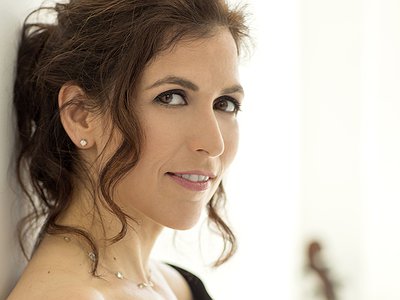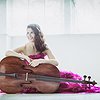Could you describe your creative process on the basis of a piece or album that's particularly dear to you, please? Where did the ideas come from, how were they transformed in your mind, what did you start with and how do you refine these beginnings into the finished work of art?
For this album, the creative process was very organic. For example, unlike when I recorded the Bach cello suites, I questioned everything. This time, I played the Chopin sonata which I grew up playing, and I felt at home with it. I can’t even remember how I started working on it but I performed it in Montpellier years ago and the entire tour was magical. The Grieg sonata was new to me but the language was and is very familiar. It was easy and I could rely on my instincts for the most part.
Ideas just come, there is really no need to look for them under the carpet because they are in the music. Juho Pohjonen was extremely helpful in finding inspiration and he brought Scandinavian authenticity to the performance. Everything just fell into place. I would say that Schumann was the most difficult work on this recording, it is a more complex, multi-layered work.
There are many descriptions of the ideal state of mind for being creative. What is it like for you? What supports this ideal state of mind and what are distractions? Are there strategies to enter into this state more easily?
For me, routine is important. In my private life there is a wonderful stability as it is very important for me to have a clear mind to work. Stress is also needed in small quantities. I need to have something to work towards, an imminent deadline, or nothing gets done. I hate being bored so I constantly look for challenges.
How do you make use of technology? In terms of the feedback mechanism between technology and creativity, what do humans excel at, what do machines excel at?
Besides my YouTube masterclass vlogs, I am a new fan of harnessing technology to augment and put a new spin on traditional ways of making music. In particular, integrating electronic music and sound effects with acoustic instruments. For the past couple of years I performed a piece for cello and electronics called The Legend of Sigh which was written for me by composer Gity Razaz, and the audience response is fantastic. There is a lot that can be done with sound manipulation, loops (think one cellist orchestra), speaker placement (where does sound come from?), and much more.
Collaborations can take on many forms. What role do they play in your approach and what are your preferred ways of engaging with other creatives through playing together or just talking about ideas?
Playing chamber music with good musicians is one of the most inspiring experiences one can have. Lately, I have enjoyed playing as part of the Chamber Music Society of Lincoln Center. I also play in the Amerigo Trio with Glenn Dicterow, the former concertmaster of the New York Philharmonic orchestra and his wife, Karen Dreyfus.
Collaborating with composers is another way to grow as an artist. I recently commissioned a concerto through the Metropolitan Museum of Art, where a painting of the Versailles Palace inspired Timo Andres to write me a cello concerto. The imagery permeated the work – one can hear vanishing mirror images, French baroque ornamentation, and odd proportions as depicted in the painting. Working with this composer taught me a lot about images in music.
My latest collaboration is with composer Anna Clyne who is currently in the process of writing me a cello concerto. I will perform it with conductor Marin Alsop (who introduced me to Anna) and four major orchestras in the US. We will also record it with the London Philharmonic Orchestra.
How is preparing music, playing it live and recording it for an album connected? What do you achieve and draw from each experience personally? How do you see the relationship between improvisation and composition in this regard?
Each step of the way is crucial. There is no substitute to performing and interacting with a live audience. I often learn what works, and more importantly, what doesn’t work, when I am on stage. It is also easier to see the “big picture” that way. During a recording session, the focus is more on details. When preparing, I also focus on the details, I try to follow the composers wishes as closely as I can. On stage I experiment to see if that works and of course, inject my own personality into the music.
Liberties are always taken as music is just a code that each of us interprets in his or her own way – sometimes we can stretch that code to have wider meanings. We read between the lines, so-to-speak, and that’s our improvisation. To be able to improvise, one has to understand the musical language of the composer well.
How do you see the relationship between the 'sound' aspects of music and the 'composition' and 'performance' aspects? How do you work with sound and timbre?
Sound, composition, and performance are integrated. There should be no division between them. For example, we use sound to build a climax in the music and through sound we communicate the emotions that we find in music. Desperation, elation, beauty, and also ugliness sometimes. Timbre helps to bring different characters in the music to light, as if not only one actor is on stage, but a few different ones.
There are works that highlight the cello sound, such as the Grieg and Chopin sonatas on my new CD, and then there are others where the cello sound is not meant to be beautiful. Avner Dorman’s cello concerto, where the playing is percussive, like a cello that forgot it was a cello, is an extreme example of that. But even the Beethoven piano and cello sonatas are not so much about beauty of sound as about communicating strong emotions with the sound.
Our sense of hearing shares intriguing connections to other senses. From your experience, what are some of the most inspiring overlaps between different senses - and what do they tell us about the way our senses work? What happens to sound at its outermost borders?
This question brings back the idea of communication which is so integral to what we do as artists. We have a message to convey, a message from the composer and from us, the performers, and we try to be the best messengers that we can be. This message is passed through our audience’s ears and in a live performance, also through their eyes. Why do we get goose bumps when we hear a great performance? Why do we feel like we want to cry, or laugh or just that we are better people after we leave the concert hall? It is something that is beautifully mystical. I think it has to do with the fact that we are social creatures and we love giving and receiving messages.
Art can be a purpose in its own right, but it can also directly feed back into everyday life, take on a social and political role and lead to more engagement. Can you describe your approach to art and being an artist?
I think of myself as predominantly a-political but I realise that this is close to impossible. There are different causes that I am drawn to, whether I admit them or not. I am a woman, and as such I like promoting works by women composers, and have done so over the last few years. I am also Israeli and Jewish and not only enjoy playing and commissioning works by Israeli and Jewish composers, but also feel proud doing so, representing my beautiful country in the best way I know how.
One of the works I play often is by an Iranian composer. We (the composer and I) have agreed without words not to politicise our partnership, but I am happy and proud that we make our small contributions to make the world a better place.
It is remarkable, in a way, that we have arrived in the 21st century with the basic concept of music and performance still intact. Do you have a vision of music and performance, an idea of what they could be beyond their current form?
Technology is a wonderful tool that I have been using more and more recently. One of my favourite recital programs is a solo Bach evening, a recital that includes a screening of a short documentary that was made about my recording of the Bach cello suites. Following the screening, I usually perform two or three of the cello suites, and finally, I take questions from the audience. This way of interacting with audiences is very personal and the response is overwhelmingly positive.
Also, while the use of digital music is already here, I don’t think it has reached its potential. I look forward to seeing more of what can be done with sound manipulation with the help of our beloved computers.



